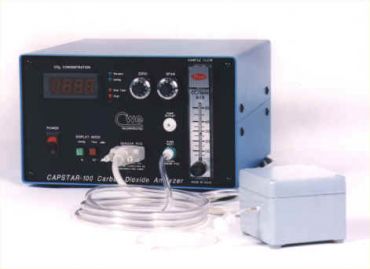CWE MRI-1 Ventilator
MR-compatible ventilator system for imaging applications
Standard Features:
● Non-magnetic pneumatic valves
● Dependable all-electronic ventilator
● Wide tidal volume and rate range
● Mice to guinea pig size
● Safe with oxygen and anesthesia
● Direct readout of volume and rate
The MR-1 Ventilator is a small animal ventilator designed for use in MRI and other high magnetic environments. The system compromises a microprocessor-based control unit and a set of remote, pneumatically operated, non-magnetic valves. The MRI-1 can operate by itself or can be controlled and/or monitored by a computer.
The MRI-1 valve set requires two pneumatic control tubes to the ventilator (at right on each picture); one drive the valve into inspiration, the other into expiration. The third flexible tube carrier the inspiratory airflow to the valve. The left side of each picture show the "I" and "E" tube to the animal's endotracheal tube. Note that flow is unindirectional, so the only dead space is contained in the distal end of the "Y" connector at the tracheal tube.
How it works: The MRI-1 operates on the flow-time principle: an inspiratory airflow is established and gated into the animal for a known time, thus producing a known volume. This approach provides extraordinary flexibility - a wide range of volumes, breaths-per-minute, and I/E ratios are possible with no hardware changes, and using just three front-panel controls. For small animals, respiratory airflow is provided by an internal airpump. Alternatively, an external pressurized gas source can be attached (oxygen or anesthetic gasses).
The remote pneumatic valves do the actual airflow switching. By locating these valves close to the animal (including insight the magnet bore if necessary), dead-space and tubing compliance are minimized. A range of valves is now available for animals ranging from mice to pigs. Rodent-size valves are supplied standard, and larger valves can be purchased later as required.
Operation: Setting up and operating the MRI-1 is easy. Flexible tubing connect the control unit and the valves, providing respiratory airflow and pneumatic control pressure to the valve. Only three controls are required: respiratory rate is set in breaths/minute; the flow rate is set using the front-panel flowmeter (and measured internally by a mass flowmeter); and the percent inspiration is set to establish the ratio of inspiration to expiration time (I/E ratio). All respiratory parameters are shown on the front-pnale LCD display. The tidal volume and minute ventilation reflecting the current settings is also continuously displayed, and can easily be changed by adjusting the flow rate.
Expandable: The MRI-1 can also be used in other magnetic environments. Because of the non-electroical nature of the ventilation valves, this unit is particularly well suite to sensitive electrophysiology recording situations. Besides the standard miniature pneumatic valves, the MRI-1 also accepts any of the solenoid valve assemblies available for the popular SAR-830 series ventilators. Using the MVA-4 multi-valve expander, it is also possible to ventilate several rodent-sized animals simultaneously using just one MRI-1 as the control unit. The external valves operate synchronously, but tidal volumes are independently set by varying the flow rate to each valve assembly.
Installation requirements: A source of compressed air of helium (approx. 20 - 50 psi) is required for operating the pneumatic valves. This is attached to the rear panel of the unit, and the pressure is internally switched on or off as required for remote valve operation. Helium is often used as a actuating gas because its lower density and viscosity permits somewhat faster valve switching. All models feature switchable 120/240 VAC operation.
<tr>
<td> </td>
<td> </td>
</tr>
<tr>
<td colspan="2">The <strong>MRI-1 valve set</strong> requires two pneumatic control tubes to the ventilator (at right on each picture); one drive the valve into inspiration, the other into expiration. The third flexible tube carrier the inspiratory airflow to the valve. The left side of each picture show the "I" and "E" tube to the animal's endotracheal tube. Note that flow is unindirectional, so the only dead space is contained in the distal end of the "Y" connector at the tracheal tube.</td>
</tr>
</table>
| Respiratory Rate Range | 5 - 150 breaths/min. |
| Inspiratory Flow Range | 50 - 1000 ml/min. |
| Inspiration/Experation (I/E ratio) Range | 20 - 80% |
| Tidal Volume Range | 0.1 - 30 ml |
| Manual Control Functions | HOLD (suspends inspiration), MAN (manual inflation) |
| LCD panel | 4 lines x 20 chars, backlit |
| Indicator Light | INSPIRATION, LOW, PRES WARNING, ERROR |
| Internal Airpump Capacity | 4 lpm |
| Pneumatic Valve Switching Speed (Air Actuation) | <75 mS |
| Pneumatic Valve Switching Speed (Helium Actuation) | <55 mS |
| Pneumatic Valve Actuation Pressure | 3 - 5 bar |
| Pneumatic Valve Flow Orifices | 2.0 mm |
| Pneumatic Valve Materials | PTFE body, non-metallic fasteners, one non-ferrous coil spring |
| Port Cconnections, Respiratory and Pressure Functions | 3mm ID Tygon tubing |
| SYNC OUT Connector | BNC Jack |
| Data Port Connector | DB-25S |


